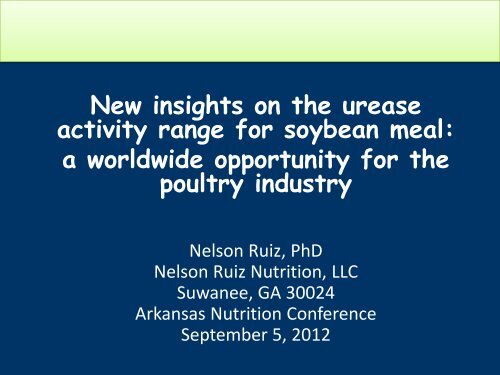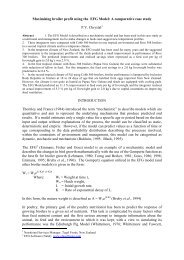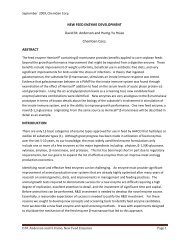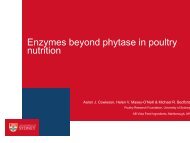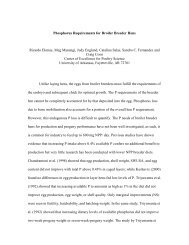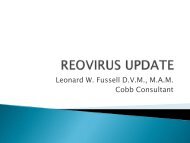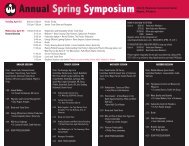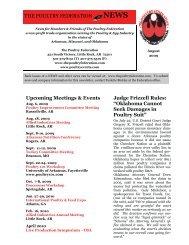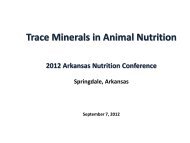PowerPoint-Nelson Ruiz - The Poultry Federation
PowerPoint-Nelson Ruiz - The Poultry Federation
PowerPoint-Nelson Ruiz - The Poultry Federation
Create successful ePaper yourself
Turn your PDF publications into a flip-book with our unique Google optimized e-Paper software.
New insights on the urease<br />
activity range for soybean meal:<br />
a worldwide opportunity for the<br />
poultry industry<br />
<strong>Nelson</strong> <strong>Ruiz</strong>, PhD<br />
<strong>Nelson</strong> <strong>Ruiz</strong> Nutrition, LLC<br />
Suwanee, GA 30024<br />
Arkansas Nutrition Conference<br />
September 5, 2012
Objective<br />
<strong>The</strong> subject of the discussion today is the<br />
urease activity range<br />
0.05 – 0.20 pH units
UREASE ACTIVITY RANGE<br />
Δ pH = 0.05-0.20<br />
(INDICATED ADEQUATE SBM PROCESSING)<br />
< 0.05 = CONCERNS ABOUT OVERHEATING<br />
> 0.20 = CONCERNS ABOUT UNDERHEATING<br />
OVERHEATED<br />
UNDERHEATED<br />
MAILLARD REACTIONS<br />
AFFECTS AMINO ACID<br />
DIGESTIBILITY<br />
“LYSINE”<br />
ANTI-NUTRITIONAL<br />
FACTORS<br />
TRYPSIN INHIBITORS<br />
LECTINS
Agenda<br />
• Literature review<br />
– Challenges to the range<br />
• Rapid feed passage in broilers and the upper<br />
limit of the urease activity range<br />
• Why the urease activity range should be<br />
changed to 0.000 – 0.050 pH units<br />
• Implications to the poultry industry worldwide
Literature review<br />
A careful review of the <strong>Poultry</strong> Science journal<br />
back to 1981 and the Applied <strong>Poultry</strong> Research<br />
Journal back to vol. 1, reveals that both the<br />
lower level and the upper level of the range<br />
have been challenged just a couple of times.
Literature review<br />
In 1987 Dale et al. at the Georgia Nutrition<br />
Conference presented evidence that the lower<br />
level of the range was basically baseless.<br />
Soybean meals (SBM) with urease activity (UA)<br />
values below 0.05 pH units not necessarily<br />
resulted in poor performance of broiler<br />
chickens
Literature review<br />
Actually, not only urease activity was unable to<br />
predict overheating of SBM, a very different<br />
in vitro technique was necessary to estimate<br />
overheating: solubility of the protein in a<br />
0.2% KOH solution
Effect of heating raw soy flakes<br />
on chick performance and in vitro parameters<br />
Heat<br />
Treatment<br />
(minutes)<br />
Body<br />
Weight gain<br />
(g)<br />
Feed/Gain<br />
Urease<br />
Activity<br />
(pH units)<br />
KOH<br />
Protein<br />
Solubility, (%)<br />
0 (raw) 342 2.44 2.40 99<br />
5 429 2.29 2.04 88<br />
10 481 2.00 0.23 79<br />
15 496 2.09 0.00 75<br />
20 450 2.03 0.00 72<br />
30 407 2.33 0.00 58<br />
60 296 276 0.00 38<br />
(Combined data of two experiments, Dale et al., 1987)
Literature review<br />
Waldroup and co-workers (1985)<br />
documented at Arkansas that the upper<br />
level of the UA range can be as high as<br />
0.50 pH units without detrimental effect<br />
on broiler performance.
Rapid Feed Passage
Rapid Feed Passage<br />
Rapid feed passage events in broiler flocks<br />
started to be reported in different<br />
geographies in the 1990s
Rapid Feed Passage<br />
• Kouwenhoven et al., 1992<br />
• López et al., 1998<br />
• Butcher et al., 1999<br />
• Miles and Butcher, 2002
Rapid feed passage is defined as the<br />
condition in which…<br />
• Droppings lose their normal shape<br />
• Do not display the characteristic uric acid<br />
cover<br />
• Contain undigested feed visible to the naked<br />
eye<br />
• Droppings have a yellowish-orange color
Feed passage syndrome in broiler chickens<br />
Rapid feed passage is defined as the<br />
(“tránsito rápido in Spanish)<br />
condition in which…<br />
• Droppings are watery, although not always<br />
• Litter becomes wet and slippery<br />
• Droppings contain more sloughed intestinal<br />
tissue than normal.<br />
• Birds lack uniformity<br />
• Birds display poor pigmentation<br />
• Upon necropsy proventriculitis is frequently<br />
observed, but not always
Feed passage syndrome in broiler chickens<br />
Rapid feed passage is defined as the<br />
(“tránsito rápido in Spanish)<br />
condition in which…<br />
As a consequence of a feed passage outbreak:<br />
- Litter quality is poor<br />
- Feed conversion is negatively affected<br />
- Body weights are lower than the standard<br />
- Economic losses can be huge
Feed passage syndrome in broiler chickens<br />
Rapid feed passage outbreaks<br />
(“tránsito rápido in Spanish)<br />
• Between 1998 and 2004 I was exposed to six<br />
major RFP outbreaks in 4 different South<br />
American Countries while working for the<br />
ContiLatin Division of the Continental Grain<br />
Company.<br />
• Although we didn’t have a clue about what<br />
was the cause, one thing was for sure: SBM<br />
was involved.
Feed passage syndrome in broiler chickens<br />
Rapid feed passage outbreaks<br />
(“tránsito rápido in Spanish)<br />
By the time the 6th outbreak hit (2004) we<br />
had already a pretty good idea that high<br />
trypsin inhibitors in SBM were correlated to<br />
these outbreaks, but only until this event we<br />
were able to collect sufficient evidence to<br />
conclude that indeed such a correlation<br />
existed.
Feed passage syndrome in broiler chickens<br />
Rapid feed passage outbreaks<br />
(“tránsito rápido in Spanish)<br />
• Based on the analyses of these six outbreaks<br />
<strong>Ruiz</strong> and Belalcázar presented their<br />
conclusions at the 2005 PSA meeting.<br />
• A detailed description of these outbreaks was<br />
published in Feedstuffs in January of 2012
Feed passage syndrome in broiler chickens<br />
Rapid feed passage outbreaks<br />
(“tránsito rápido in Spanish)<br />
Rapid feed passage is known as “transito<br />
rapido” in Spanish, and as a form of<br />
“dysbacteriosis” in Europe and other countries
What this rapid feed passage<br />
issue has to do with the upper limit of<br />
the urease activity range
RAPID FEED PASSAGE OUTBREAKS IN LATIN AMERICA<br />
“RELATIONSHIP TO UREASE ACTIVITY AND TRYPSIN INHIBITOR”<br />
COUNTRY<br />
ECUADOR<br />
COLOMBIA<br />
ECUADOR<br />
COLOMBIA<br />
COLOMBIA<br />
VENEZUELA<br />
PERU<br />
COLOMBIA<br />
PERU<br />
COLOMBIA<br />
ECUADOR<br />
VENEZUELA<br />
COLOMBIA<br />
COLOMBIA<br />
COLOMBIA<br />
COLOMBIA<br />
TRYPSIN INHIBITOR<br />
mg/g SBM<br />
. 1.90<br />
2.20<br />
2.40<br />
2.40<br />
2.60<br />
2.80<br />
4.00<br />
4.04<br />
4.20<br />
4.82<br />
5.50<br />
5.60<br />
6.00<br />
6.80<br />
5.90<br />
7.29<br />
FEED PASSAGE<br />
OUTBREAK<br />
NO<br />
NO<br />
NO<br />
NO<br />
NO<br />
NO<br />
YES<br />
YES<br />
YES<br />
YES<br />
YES<br />
YES<br />
YES<br />
YES<br />
YES<br />
YES<br />
DATA ADAPTED FROM TABLE 2 (<strong>Ruiz</strong>, 2012) DATA PRESENTED AT PSA ANNUAL MEETING (<strong>Ruiz</strong> and Belalcazar, 2005)
Rapid feed passage outbreaks vs.<br />
(“tránsito rápido in Spanish)<br />
Trypsin inhibitors<br />
<strong>The</strong> best interpretation of the data that we<br />
had for these 6 events of RFP is that one cause<br />
(not necessarily the only one) of RFP in<br />
broilers fed SBM had to do with the trypsin<br />
inhibitor level in the meal and its level of<br />
inclusion in the formula.
Feed passage syndrome in broiler chickens<br />
Rapid feed passage outbreaks vs.<br />
(“tránsito rápido in Spanish)<br />
Trypsin inhibitors<br />
Because of these data we concluded and<br />
presented at the PSA annual meeting in 2005<br />
that trypsin inhibitor levels in commercial SBM<br />
should not be higher than 3.0-3.5 mg/g, but<br />
also suggested that the lower the TI content<br />
the better provided solubility in KOH were at<br />
least 78%.
Feed passage syndrome in broiler chickens<br />
Rapid feed passage outbreaks vs.<br />
(“tránsito rápido in Spanish)<br />
Trypsin inhibitors and UA range<br />
However, when the levels of trypsin inhibitors<br />
are related back to their corresponding values<br />
in terms of urease activity, it becomes evident<br />
that the UA values at which RFP occurs (at<br />
expected levels of inclusion of SBM by leastcost<br />
formulation) are within the current<br />
range of adequacy for SBM quality!
RAPID FEED PASSAGE OUTBREAKS IN LATIN AMERICA<br />
“RELATIONSHIP TO UREASE ACTIVITY AND TRYPSIN INHIBITOR”<br />
COUNTRY<br />
ECUADOR<br />
COLOMBIA<br />
ECUADOR<br />
COLOMBIA<br />
COLOMBIA<br />
VENEZUELA<br />
PERU<br />
COLOMBIA<br />
PERU<br />
COLOMBIA<br />
ECUADOR<br />
VENEZUELA<br />
COLOMBIA<br />
COLOMBIA<br />
COLOMBIA<br />
COLOMBIA<br />
UREASE ACTIVITY<br />
ΔpH units in SBM<br />
.01<br />
.02<br />
.03<br />
.03<br />
.05<br />
.06<br />
.09<br />
.08<br />
.09<br />
.14<br />
.17<br />
.19<br />
.25<br />
.28<br />
.29<br />
.33<br />
O.05-0.20<br />
TRYPSIN INHIBITOR<br />
mg/g SBM<br />
1.90<br />
2.20<br />
2.40<br />
2.40<br />
2.60<br />
2.80<br />
4.00<br />
4.04<br />
4.20<br />
4.82<br />
5.50<br />
5.60<br />
6.00<br />
6.80<br />
5.90<br />
7.29<br />
FEED PASSAGE<br />
OUTBREAK<br />
NO<br />
NO<br />
NO<br />
NO<br />
NO<br />
NO<br />
YES<br />
YES<br />
YES<br />
YES<br />
YES<br />
YES<br />
YES<br />
YES<br />
YES<br />
YES<br />
DATA ADAPTED FROM TABLE 2 (<strong>Ruiz</strong>, 2012) DATA PRESENTED AT PSA ANNUAL MEETING (<strong>Ruiz</strong> and Belalcazar, 2005)
Y<br />
R 2 = 0.9308<br />
Y = 0.056(X)<br />
- 0.0814<br />
X = Y + 0.0814<br />
0.0564<br />
X
UREASE ACTIVITY (pH units)<br />
TRYPSIN INHIBITORS vs. UREASE ACTIVITY<br />
(Belalcázar and Otálora, 2012)<br />
0.70<br />
0.60<br />
Y = 0.0738X - 0.1224<br />
R 2 = 0.9748<br />
N= 104<br />
0.50<br />
0,40<br />
0.30<br />
0.20<br />
0.10<br />
0.00<br />
0.00 1.0 2.0 3.0 4.0 5.0 6.0 7.0 8.0 9.0 10.0<br />
TRYPSIN INHIBITORS (mg/g)
Why the UA range changed<br />
• Because the bird has changed<br />
• Modern broilers are much more efficient than<br />
broilers of decades ago, but their feed intake<br />
is also much greater.
1957<br />
RANDOMLY BRED MALES SINCE 1957<br />
DAY 43 DAY 57 DAY 71 DAY 85<br />
2001<br />
HAVENSTEIN et al., 2003<br />
MALE ROSS BROILERS IN 2001
Why the UA range changed<br />
Using the data from the simulation conducted<br />
by Havenstein et al. (2003) with “1957”<br />
broilers versus “2001” broilers it is possible to<br />
estimate the trypsin inhibitor intake of the<br />
“1957” birds fed 1957 diets and compare it<br />
with the estimate of TI intake by the “2001”<br />
birds fed 2001 diets.
TRYPSIN INHIBITOR INTAKE<br />
FROM 48% SOYBEAN MEAL<br />
PERFORMANCE DATA<br />
(42 DAYS OF AGE)<br />
AND<br />
DIET COMPOSITION<br />
TAKEN FROM<br />
HAVENSTEIN et al., 2003<br />
AVERAGE<br />
BODY WT<br />
AVERAGE<br />
FEED INTAKE<br />
(g)<br />
TI CONTENT<br />
IN SBM<br />
(mg/g)<br />
AVERAGE DIET<br />
TI CONTENT<br />
(mg/g)<br />
AVERAGE CUMULATIVE<br />
TI INTAKE<br />
(mg/BIRD)<br />
1957<br />
539<br />
1261<br />
2<br />
4<br />
6<br />
0.476<br />
0.952<br />
1.428<br />
600<br />
1200<br />
1800<br />
2001<br />
2672<br />
4355<br />
2<br />
4<br />
6<br />
2007<br />
4014<br />
6021
Feed passage syndrome in broiler chickens<br />
Trypsin inhibitors vs Urease activity<br />
(“tránsito rápido in Spanish)<br />
Trypsin Inhibitor<br />
content in SBM 48<br />
mg/g<br />
Expected Urease Activity<br />
in SBM 48<br />
pH units<br />
2 0.000-0.055<br />
3 0.062-0.136<br />
4 0.136-0.210<br />
5 0.210-0.284<br />
6 0.284-0.357
Consequently…<br />
THE RECOMMENDED NEW RANGE<br />
SHOULD BE 0.000 – 0.050<br />
pH UNITS
Implications for the poultry<br />
industry worldwide<br />
First, it is time for the poultry industry to<br />
adjust quality standards to today's reality.<br />
Broiler producers are losing money every time<br />
they have to deal with a rapid feed passage<br />
outbreak in the field.
Implications for the poultry<br />
industry worldwide<br />
<strong>Poultry</strong> companies know how much it costs<br />
them and the industry each year if a rapid<br />
feed passage outbreak results in a loss of just<br />
one point of feed conversion. <strong>The</strong> losses don't<br />
stop with poor feed conversion because the<br />
more trypsin inhibitors present in the feed,<br />
the wetter the litter is going to be.
Implications for the poultry<br />
industry worldwide<br />
Poor quality litter relates to poorer air quality<br />
due to ammonia, poorer flock uniformity,<br />
downgraded carcasses due to blistered breasts<br />
and loss of the paws to their specific markets.
Implications for the poultry<br />
industry worldwide<br />
Second, it is an opportunity for both the oilseed<br />
and poultry industries to come together and<br />
discuss the reasons why such a change is<br />
needed with respect to the adequacy of the<br />
urease activity range which is presently being<br />
used. Trading on the basis of quality is a winwin<br />
situation for all concerned
Implications for the poultry<br />
industry worldwide<br />
Let’s just assume that the trading range is 0.000-<br />
0.050 pH units as proposed above. <strong>The</strong>n let’s<br />
propose a margin of variation of up to 0.070<br />
pH units, but after 0.075 pH units a discount<br />
table is established or negotiated in a manner<br />
similar to those used in discounts for crude<br />
protein and moisture.
Implications for the poultry<br />
industry worldwide<br />
Alternatively, a premium may be negotiated for<br />
the new range (again, provided solubility of<br />
the protein in KOH is at least 78%) with the<br />
premium being discounted beyond 0.075 pH<br />
units, for instance.<br />
.
Implications for the poultry<br />
industry worldwide<br />
Third, a considerable amount of work has being<br />
published in reference to the toxicity of<br />
trypsin inhibitors (and other antinutritional<br />
factors in raw soybeans) which clearly<br />
document that birds (broilers, layers,<br />
breeders) do not adapt to high trypsin<br />
inhibitors in the diet (Nesheim and Garlich,<br />
1966; <strong>Ruiz</strong> et al., 2008).
Implications for the poultry<br />
industry worldwide<br />
<strong>The</strong>refore, it would be advantageous to<br />
continue to develop commercial soybean lines<br />
that have low concentrations of or no trypsin<br />
inhibitors and market them because of their<br />
added value.
Feed passage syndrome in broiler chickens<br />
South American corn contaminated with<br />
(“tránsito rápido in Spanish)<br />
fractions of raw soybeans<br />
This is a fact:<br />
Imported Argentine and Brazilian corn have<br />
arrived in Colombia with 0.30-0.40 mg of<br />
trypsin inhibitors per gram
FIELD<br />
THANK<br />
DATA CONFIRMATION<br />
YOU<br />
BY<br />
VERY<br />
LABORATORY<br />
MUCH<br />
EXPERIMENTS<br />
SBM<br />
SBM<br />
McNAUGHTON et al. (1981)<br />
BROILERS (21 DAYS OF AGE)<br />
UREASE ACTIVITY<br />
(pH 0.02)<br />
TRYPSIN INHIBITORS<br />
(1.77 MG/G)<br />
EXCELLENT<br />
PERFORMANCE<br />
UREASE ACTIVITY<br />
(pH 0.19)<br />
TRYPSIN INHIBITORS<br />
(12.12 MG/G)<br />
VERY POOR<br />
PERFORMANCE<br />
CLARK AND WISEMAN (2007)<br />
BROILERS (25 DAYS OF AGE)<br />
SBM<br />
TRYPSIN INHIBITORS<br />
(1.90 MG/G)<br />
EXCELLENT<br />
PERFORMANCE<br />
HIGH ILEAL AMINO ACID<br />
DIGESTIBILITY<br />
Y = 0.056(X)<br />
- 0.0814<br />
UREASE ACTIVITY<br />
(pH 0.025)


